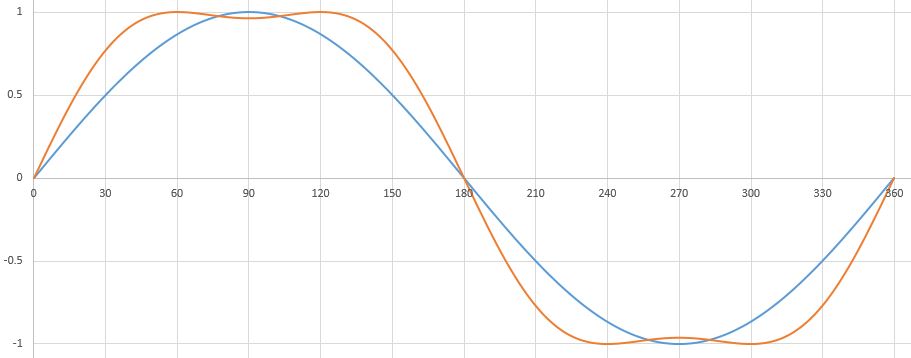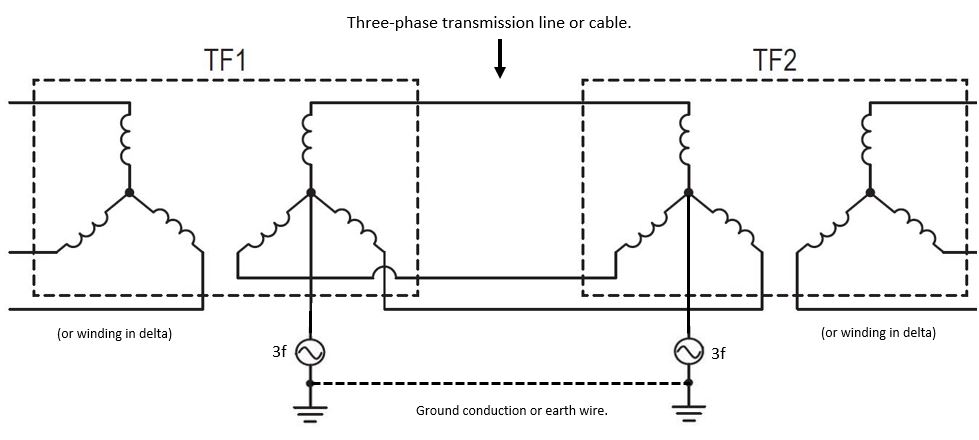This website may also be reached via www.powermaximizer.com, www.energymaximiser.com, www.energymaximizer.com.

The Power Maximiser Principle
13 February 2022. A new UK patent application filed. Contains multiple inventions encompassing the most recent developments. Divisional applications anticipated. Go to Patents tab.
* Blocking the propagation of 3f currents. * Transformerless injector. * Superposition of 1f and 3f power systems to give desired waveform along the lines. * Combining triple harmonic injection with quadrature voltage injection. * Single unit starpoint 3f and quadrature 1f injection. * Transformer modification in retrofit situations to avoid transformer replacement.
6 June 2022 A new presentation added outlining benefits, challenges, solutions and theory. Go to Power and Energy tab.
* Double end driving necessary for waveform shape preservation along the line. * Understanding and analysis of this is best achieved by identifying the arrangement as a 1f 3-phase power system with a superimosed 3f 1-phase system. * The 3f injectors emulate solid starpoint grounding. * VA requirments of the injectors is small. * Starpoint and series 3f injection can be combined with silicon-based quadrature voltage injection for line power increase as well as power steering.
1 September 2022. A new document looking at the benefits available from Third Harmonic Injection. Go to the Resources tab.
* Choose between increasing the power rating of the transmission line or improving its efficiency. * Or some of both. * Discusses the role of δ in implementing the choice. * A possible alliance between third harmonic injection and quadrature voltage injection.
12 September 2022. A new document is published in Resources analysing the THI system as a double system favoring three-phase operation.
A new document is published in "Resources". illustrating how the third-harmonic-injection system can be viewed as a double system - a three-phase system operating at fundamental frequency and a single-phase system operating at triple frequency. The power flow due to the single-phase system is small but it facilitates a major increase in the power rating of the three-phase system.
General Principles
Adding 1/6th third harmonic to the ac supply waveform (a sinusoid) permits the maximum theoretical power capability of a transmission system to be increased by 33%. Alternatively the power can be kept constant and voltage increased and current reduced thereby lowering line losses due to resistance by up to 33%.
Third harmonic injection gives some of the benefits of DC transmission while keeping the immense advantages of AC. As the waveforms above illustrate, third harmonic injection in a section of a transmission system allows that section to operate for most of each cycle at close to peak allowable voltage.
Adding 1/6th of third harmonic lowers the peak value of a sinusoidal waveform by a factor of 0.866. Restoring the combined waveform to the allowable peak value for the transmission line raises the fundamental voltage by a factor of 1.155. This principle has been widely used for many years to raise the output voltage in three-phase inverters. ("The use of harmonic distortion to increase the output of a three-phase PWM inverter". Houldsworth J.A. and Grant D.A. IEEE Transactions of the Industry Applications Society, Sept 1984, pp 1224-1228). The P(max) of a power transmission line is proportional to V2. Therefore the raising of the fundamental voltage theoretically permits P(max) to be increased by a factor of 1.33. The blue waveform shown above is the line-ground waveform before the addition of the third harmonic. The orange waveform is the line-ground voltage after the addition of the third harmonic and amplification by 1.156.
In conventional ac power systems which employ a pure sine wave, the line-to-line Voltage is limiteThis will be the first time since Tesla that we have put something other than a basic sine wave on our ac power lines. The benefits are more power capacity and reduced losses. The third harmonic is stripped out as the power passes through the receiving end transformer – or if advantageous, it can be taken out later – or not at all depending on the end use.d by the peak permitted line-to-ground Voltage. By breaking that link by adding a third harmonic we allow the line-to line Voltage to be increased by 15.6% and the power limit increased by up to 33%.
For a pure sine wave, V(line-to-line) = Vpk(line-ground)/√2 x √3 = Vpk(line-ground) x 1.225
For a sine wave plus third harmonic, V(line-line) = Vpk(line-ground) x 1.156/√2 x √3 = Vpk(line-ground) x 1.416
A pure sine wave uses the maximum allowed line-ground Voltage once every half cycle.
A sine wave plus third harmonic uses the maximum allowed line-ground Voltage twice every half cycle.
Adding a third harmonic moves the performance of an ac line closer to that of a dc line.
This will be the first time since Tesla that we have put something other than a basic sine wave on our ac power lines. The benefits are more power capacity and reduced losses.
The third harmonic is stripped out as the power passes through the receiving end transformer – or if advantageous, it can be taken out later – or not at all depending on the end use.
The simplest way to implement this principle is by connecting the sending end and receiving end transformer windings in star and by applying the triple frequency voltage waveform to each star point as shown below

The transmission system therefore operates to some extent at the triple frequency as well as the fundamental frequency. This creates challenges for the triple frequency injectors (labelled 3F in the circuit diagram). We offer a solution to the challenges created by fundamental-frequency zero-sequence currents in the injectors (patent applied for). We have also have a range of solutions for the challenges of integrating this technology into new or existing power transmission systems (patent applied for). See Power and Energy. Further patent activity is envisaged, relating to line injection of the third harmonic, control of the propagation of the third harmonic and special three-phase transformers for this application. See Patents.
We would welcome expressions of interest from potential partners in developing this evolving technology. (See Contact Us).